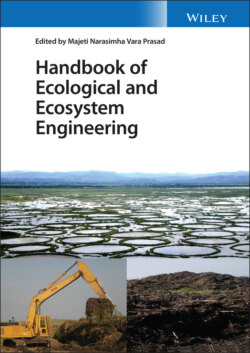Читать книгу Handbook of Ecological and Ecosystem Engineering - Группа авторов - Страница 40
3.4.1 Coastal Ecosystem Restoration
ОглавлениеProtection and preservation of coastal regions were traditionally meant to safeguard against flooding. However, incomplete knowledge about the state of the system with this traditional approach often impacted the local ecology negatively and caused unpredicted outcomes that eventually affected the ecosystem more significantly. Incorporating ecological services into coastal ecosystem protection and restoration, due to the need for novel, cost‐effective, sustainable designs for solving problems like rising sea levels due to climate change and minimizing the anthropogenic impacts on these ecosystems, has attracted the attention of many researchers [13].
To fulfill the objectives of coastal ecology restoration, the methods used should be selected based on the paradigm of a few species (such as mussel beds, oyster beds, and vegetation) that can participate in the enhancements with their ability to modify/save the physical structure of the environment; the construction of dams or dikes also enhances ecosystem' biodiversity. In addition, the unique ability of these species to trap and stabilize sediments in intertidal areas leads to soil elevation and attenuation of tides; they are also suitable for construction of low‐cost, sustainable dams. For example, marram grass (Ammophilaarenaria) can trap sand, hence building protective sand dunes that invigorate dikes in sandy coastal regions. Dams or dikes constructed with reef‐forming shellfish species, coral reefs, wetlands, or mangrove forests are self‐sustaining and require low maintenance, minimum reinforcement, and less financial assistance.
Complex engineering designs often find it impossible to incorporate ecosystem engineering species into a system's local demographic conditions. In such cases, traditional designs can be revised to enhance inhabitability by simply modifying ecological structures with better ecological values for coastal protection purposes. This may not result in a cost‐effective approach, but mitigation of engineering impacts on ecology is definitely realized with acceptance from the local community.
The primary goal of coastal protection is to protect the land from seasonal floods and erosion of shorelines. An occasional or annual flood threatens a large geographic scale with mostly temporary damage, while the erosion of shorelines is very site‐specific and has a greater impact on the entire coastline [61]. Groyns and revetments are traditional protective measures that minimize the threats of shoreline erosion; dams are constructed to prevent floods and protect the mainland on a larger scale, whereas breakwaters are effective against both floods and erosion on a smaller scale. A comprehensive and integrated assessment and evaluation of the coastal ecosystem for management, maintenance, stabilization, and protection has become the primary focus of recent researchers seeking to develop innovative methodologies [51]. Weight of evidence (WOE) [1], ecological risk assessment (ERA) [9], and the ecosystem services approach (ESA) [57] are among several well‐designed assessment models that emphasize pollution rather than the validation of ecosystem integrity; a few integrative approaches primarily focus on the assessment of ecosystem health. Nevertheless, an integrated ecosystem health assessment approach (IEHA) in combination with ecological indexes results in better evaluation of community structures at a macro level as well as biodiversity measures of ecological systems [14, 29].
According to a report by Brown and McLachlan [7], more than 80% of sedimentary shorelines are lost due to construction of artificial structures in coastal areas. With the replacement of coastal marshes by brick walls, benthos are immensely effected on either side of the wall [47], although the exact cause for the adverse effects on adjacent habitats is difficult to pinpoint. As an example, natural rocky shores of Sydney Harbor are affected by the disintegration of the shore due to the infrastructure of intertidal seawalls and urbanization [20]. A case study by Burt and Bartholomew [8]discussed coastal development and modification in the Arabian Gulf by encouraging colonization of fish and corals to enhance ecological benefits, integrity, and sustainability of modern urban development. Similarly, a case study in the Jiangsu coastal area of China based on a dimensionless polygon area method reflected the structure, health, and function of an ecosystem that greatly depends on temporal5 and spatial6 changes. The results of this assessment may be applicable for policy makers as a reference for the planning and development of coastal areas [52].
